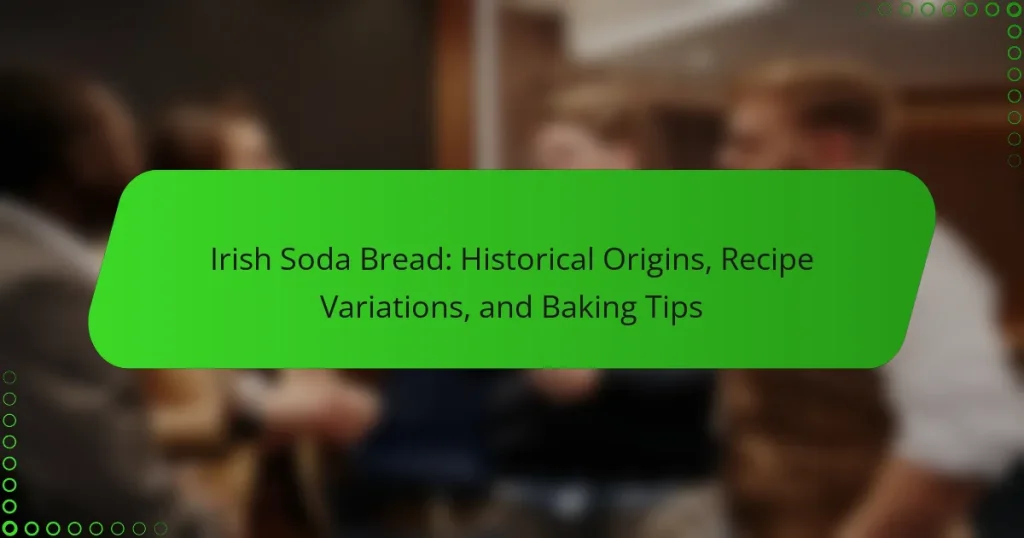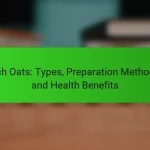Irish soda bread is a traditional Irish bread that utilizes baking soda as a leavening agent, distinguishing it from yeast-based breads. Made from simple ingredients such as flour, buttermilk, and salt, it features a dense texture and a slightly tangy flavor. The article explores the historical origins of Irish soda bread, its variations—including brown soda bread, white soda bread, and soda farls—and regional adaptations that reflect local ingredients. Additionally, it provides essential baking tips to achieve the ideal texture and flavor, ensuring that readers can successfully create this iconic bread at home.

What is Irish Soda Bread?
Irish soda bread is a traditional Irish bread made using baking soda as a leavening agent. It typically contains simple ingredients such as flour, buttermilk, and salt. The absence of yeast distinguishes it from other bread types. This bread is known for its dense texture and slightly tangy flavor from the buttermilk. Historically, it became popular in Ireland during the 19th century due to the availability of baking soda. The use of buttermilk also reflects local agricultural practices. Irish soda bread is often shaped into a round loaf and scored with a cross on top before baking. This scoring helps the bread cook evenly and is said to ward off evil spirits.
How did Irish Soda Bread originate?
Irish Soda Bread originated in Ireland during the 19th century. It was developed as a quick and easy bread-making method. The use of baking soda as a leavening agent became popular due to the availability of soda in Ireland. Traditional recipes used simple ingredients like flour, baking soda, salt, and buttermilk. This combination allowed for a bread that required no yeast and minimal time to prepare. The bread’s creation was influenced by the need for affordable and accessible food during times of hardship. Irish Soda Bread became a staple in Irish households, reflecting the country’s culinary heritage.
What historical factors contributed to the development of Irish Soda Bread?
Irish Soda Bread developed due to several historical factors. The introduction of sodium bicarbonate as a leavening agent in the 19th century was crucial. This innovation allowed for quicker bread-making processes. Traditional yeast breads required longer fermentation times, which were challenging in rural Ireland.
The availability of soft wheat in Ireland also influenced its development. Soft wheat has lower gluten content, making it suitable for soda bread. Economic factors played a role as well. During the Great Famine in the mid-19th century, families needed affordable and quick-to-make food.
Soda bread became a staple due to its simplicity and the use of readily available ingredients. The cultural significance of baking in Irish households further solidified its place in daily life. Overall, these factors combined to create the unique and enduring tradition of Irish Soda Bread.
How did the availability of ingredients influence its creation?
The availability of ingredients significantly influenced the creation of Irish Soda Bread. In Ireland, traditional bread-making relied on locally sourced components. The scarcity of yeast during the 19th century led to the adoption of baking soda as a leavening agent. This substitution allowed for quicker bread preparation. Additionally, the use of buttermilk became common due to its availability as a byproduct of butter production. The incorporation of whole grain flours reflected the agricultural practices of the region. These factors combined to create a bread that was both practical and suited to the Irish diet. Historical records show that this adaptation was essential for sustaining communities during times of hardship.
What are the key ingredients in Irish Soda Bread?
The key ingredients in Irish Soda Bread are flour, baking soda, salt, and buttermilk. Flour serves as the primary structure of the bread. Baking soda acts as the leavening agent, helping the bread rise. Salt enhances flavor and balances the bread’s taste. Buttermilk provides acidity, which reacts with baking soda to create a light texture. These ingredients are traditionally mixed to form a dough and baked quickly, resulting in a dense, hearty bread.
What role does baking soda play in the recipe?
Baking soda acts as a leavening agent in the recipe for Irish soda bread. It reacts with acidic ingredients, such as buttermilk, to produce carbon dioxide. This gas creates bubbles that help the bread rise. The reaction occurs quickly, allowing for a faster baking process. Traditional recipes often rely on baking soda instead of yeast. This results in a denser texture compared to yeast-leavened breads. The use of baking soda is a key characteristic of Irish soda bread. It contributes to the unique flavor and crumb structure of the final product.
How do different flours affect the texture and flavor?
Different flours significantly affect the texture and flavor of Irish soda bread. All-purpose flour creates a soft, tender crumb due to its moderate protein content. Whole wheat flour adds a nuttier flavor and denser texture because of its higher fiber content. Bread flour, with its higher protein, results in a chewier texture and more structure. Gluten-free flours, like almond or rice flour, can produce a crumbly texture and vary in flavor profiles. The presence of bran in whole wheat flour can also impart a slightly bitter taste, contrasting with the mildness of all-purpose flour. These variations in flour types lead to distinct sensory experiences in the final bread product.

What are the variations of Irish Soda Bread?
Irish Soda Bread has several variations. Common types include brown soda bread, which uses whole wheat flour. White soda bread is made with all-purpose flour. Another variation is soda farls, which are fried in a pan. Some recipes incorporate ingredients like raisins or caraway seeds for added flavor. There are also regional variations, such as the addition of buttermilk or yogurt. Each variation reflects local preferences and available ingredients. These differences contribute to the diverse culinary heritage of Irish soda bread.
What are the traditional types of Irish Soda Bread?
The traditional types of Irish Soda Bread include brown soda bread and white soda bread. Brown soda bread is made with wholemeal flour, giving it a dense texture and nutty flavor. White soda bread uses refined white flour, resulting in a lighter and softer loaf. Another variant is the sweet soda bread, which incorporates sugar and raisins or currants, often enjoyed as a treat. Additionally, there is the buttermilk soda bread, which uses buttermilk for moisture and flavor. Each type reflects regional preferences and available ingredients in Ireland.
How does brown soda bread differ from white soda bread?
Brown soda bread is made primarily from wholemeal flour, while white soda bread uses refined white flour. The use of wholemeal flour gives brown soda bread a denser texture and a nuttier flavor. In contrast, white soda bread is lighter and has a milder taste. Brown soda bread often contains more fiber and nutrients due to the whole grains. White soda bread tends to be softer and is typically quicker to bake. These differences reflect traditional Irish baking practices, where brown bread was more common among rural communities.
What unique ingredients can be added to create variations?
Unique ingredients that can be added to create variations of Irish soda bread include caraway seeds, raisins, and buttermilk. Caraway seeds add a distinctive flavor that enhances the traditional taste. Raisins introduce a sweetness that contrasts with the bread’s savory elements. Buttermilk contributes to a tender crumb and a slight tang. Other unique ingredients include oats, which provide a hearty texture, and nuts, offering a crunchy contrast. Each ingredient modifies the bread’s flavor and texture, allowing for diverse interpretations of this classic recipe.
How do modern recipes adapt Irish Soda Bread?
Modern recipes adapt Irish Soda Bread by incorporating diverse ingredients and techniques. Many contemporary versions include whole grain flours, such as whole wheat or spelt, enhancing nutritional value. Some recipes introduce sweeteners like honey or brown sugar for a touch of sweetness. Others add fruits, such as raisins or cranberries, for flavor and texture.
Additionally, modern adaptations may use buttermilk alternatives, like yogurt or plant-based milks, catering to dietary preferences. Variations also exist in shaping and baking methods, with some opting for round loaves while others create smaller rolls.
These adaptations reflect a shift towards healthier and more innovative baking practices while retaining the bread’s traditional essence. The flexibility of ingredients allows for personalization, making Irish Soda Bread accessible to a wider audience.
What are some popular contemporary twists on the classic recipe?
Popular contemporary twists on Irish soda bread include adding ingredients like cranberries, walnuts, or seeds. These variations enhance flavor and texture. Some bakers incorporate herbs such as rosemary or thyme for a savory twist. Others experiment with whole wheat or gluten-free flours to cater to dietary preferences. Additionally, recipes may feature buttermilk alternatives like yogurt or plant-based milk. These adaptations maintain the essence of the classic recipe while introducing modern elements. Each twist offers a unique take on the traditional Irish soda bread, appealing to diverse palates.
How do cultural influences shape new variations?
Cultural influences shape new variations of Irish soda bread through regional ingredients and baking methods. Local traditions dictate the types of flour used, such as whole wheat or white flour. Additionally, cultural practices may introduce unique flavorings like caraway seeds or raisins. Historical events, such as the Great Famine, also influenced ingredient availability and bread-making techniques. For instance, the use of baking soda became prevalent due to its efficiency and accessibility. Variations emerged as families adapted recipes to reflect their heritage. This evolution continues today, with modern interpretations incorporating diverse influences from global cuisines.

What are the best baking tips for Irish Soda Bread?
The best baking tips for Irish Soda Bread include using fresh baking soda for optimal leavening. Ensure the buttermilk is at room temperature to activate the soda effectively. Mix the dry ingredients thoroughly before adding wet ingredients to ensure even distribution. Knead the dough gently for about 30 seconds to avoid a tough texture. Shape the dough into a round loaf and score a deep cross on top to help it rise evenly. Bake in a preheated oven at 425°F for approximately 30 minutes, or until golden brown. Let the bread cool on a wire rack to maintain its texture. These tips help achieve a light, flavorful loaf, characteristic of traditional Irish Soda Bread.
How can you achieve the perfect texture when baking Irish Soda Bread?
To achieve the perfect texture when baking Irish Soda Bread, use the right flour and maintain the correct moisture level. All-purpose flour or a mix of all-purpose and whole wheat flour provides the best results. The dough should be soft but not sticky. Incorporate buttermilk gradually until the dough comes together. Knead the dough gently for about 30 seconds to activate the gluten without overworking it. Shape the dough into a round loaf and score the top to allow for even rising. Bake at a high temperature, around 450°F (232°C), to create a crusty exterior while keeping the inside tender. These methods ensure a balanced texture typical of traditional Irish Soda Bread.
What common mistakes should be avoided during the baking process?
Common mistakes to avoid during the baking process include not measuring ingredients accurately. Accurate measurements ensure the right chemical reactions occur. Another mistake is not preheating the oven. Baking in a cold oven can lead to improper rising. Additionally, overmixing the dough can develop gluten too much. This results in a tough texture instead of a light one. Not using fresh ingredients can also hinder the final product. Old baking soda loses its effectiveness, affecting the rise. Lastly, ignoring baking time can lead to overbaking or underbaking. This can compromise the bread’s texture and flavor.
How does the baking time and temperature affect the outcome?
Baking time and temperature significantly influence the texture and flavor of Irish soda bread. Higher temperatures create a crustier exterior while reducing baking time. Conversely, lower temperatures yield a softer crust but require longer baking. The Maillard reaction, responsible for browning, occurs optimally between 300°F and 500°F. Underbaking can result in a dense, gummy interior, while overbaking leads to dryness. For instance, baking at 425°F for about 30 minutes typically produces a well-risen loaf with a balanced crust. Accurate timing and temperature control ensure the desired outcome in texture and taste.
What tools and equipment are essential for baking Irish Soda Bread?
Essential tools and equipment for baking Irish Soda Bread include a mixing bowl, a wooden spoon, and a baking sheet. A mixing bowl is necessary for combining ingredients. A wooden spoon aids in mixing the dough effectively. A baking sheet is required for holding the shaped dough during baking. Additionally, measuring cups and spoons ensure accurate ingredient quantities. A whisk can help aerate the dry ingredients. A clean kitchen surface is ideal for kneading the dough. Finally, an oven is essential for baking the bread at the correct temperature. These tools facilitate the traditional method of preparing Irish Soda Bread efficiently.
What types of pans work best for baking soda bread?
Cast iron pans and baking sheets work best for baking soda bread. Cast iron pans provide excellent heat retention and even baking. They help create a crispy crust while keeping the interior moist. Baking sheets are also effective, allowing for more surface area and quick heat distribution. Both options enable proper rising and browning of the bread. Using these types of pans results in a desirable texture and flavor.
How do different mixing techniques impact the final product?
Different mixing techniques significantly impact the texture and flavor of Irish soda bread. For instance, the traditional method involves gently combining ingredients to maintain a light, airy structure. Over-mixing can lead to a dense and tough final product due to gluten development. Conversely, folding the dough allows for better incorporation of air, resulting in a softer crumb. Specific techniques, like using a light hand or minimal kneading, preserve the bread’s natural tenderness. Research shows that proper mixing techniques enhance the rise and overall quality of baked goods, making them essential for achieving the desired outcome in Irish soda bread.
What troubleshooting tips can help with baking Irish Soda Bread?
To troubleshoot baking Irish Soda Bread, ensure you use fresh baking soda. Old baking soda loses potency, affecting rise. Check the flour for proper consistency; it should be soft and not too sticky. If the dough is too wet, add small amounts of flour until it reaches the right texture. Knead the dough gently; over-kneading can lead to a dense loaf. Bake at the correct temperature; 425°F is ideal for a good crust. If the bread is too dark on the outside, cover it with foil during baking. For a softer crust, brush the top with melted butter after baking. These tips help achieve the traditional texture and flavor of Irish Soda Bread.
How can you fix a dense loaf of Irish Soda Bread?
To fix a dense loaf of Irish Soda Bread, increase the liquid in the dough. Dense bread often results from insufficient moisture. Adding more buttermilk or water can improve the texture. Ensure that the baking soda is fresh, as old baking soda may not provide adequate leavening. Mix the ingredients gently to avoid overworking the dough. Over-kneading can lead to a tough loaf. If the loaf is already baked, you can slice it and toast it to improve its texture.
What should you do if your bread doesn’t rise properly?
If your bread doesn’t rise properly, check the yeast’s freshness. Old or inactive yeast can lead to poor rising. Ensure the dough is in a warm environment. Yeast requires warmth to activate effectively. Knead the dough adequately for proper gluten development. Insufficient kneading can result in dense bread. Verify the liquid temperature used in the recipe. Water that is too hot can kill yeast, while cold water can slow activation. Allow the dough enough time to rise; typically, one to two hours is necessary. If the dough still doesn’t rise, consider starting over with fresh ingredients.
Irish soda bread is a traditional Irish bread made primarily from flour, baking soda, buttermilk, and salt, known for its dense texture and slightly tangy flavor. This article explores the historical origins of Irish soda bread, detailing its development in the 19th century due to ingredient availability and economic factors. It also covers key ingredients, variations, modern adaptations, and essential baking tips to achieve the perfect loaf. Additionally, troubleshooting advice is provided to address common issues encountered during the baking process.


